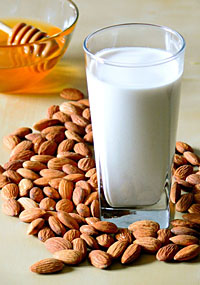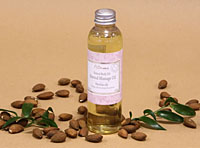Almond Milk
[ad] Empty ad slot (#1)!
Try Some Delicious and Healthy Almond Milk
Almond milk can be found in the dairy section or in shelf-stable packages at most grocery stores. It might even be available in several flavors. Once somewhat of a novelty limited to health food stores almond milk is becoming a mainstay product for many consumers. The rapid rise in its popularity is due to many factors. Annual consumption of whole milk in the United States has steadily declined from 45 gallons per capita in 1945 to just eight gallons in 2001. People are becoming more health conscious by cutting back on fat and the harmful effects some say occur from drinking dairy milk. Seeking a substitute many shoppers have turned to almond milk as a healthier alternative. The growing raw foods movement has increased demand even further and the sale of both almonds and almond milk has skyrocketed. The growth in sales of almond milk exceeds that for every other milk substitute product. These substitutes mainly include soy, rice, coconut, wheat and barley.
What Is Almond Milk?
The Romans called almonds “Greek nuts” since Greece had a long history of raising almonds. In two of Europe’s oldest cookbooks, the Viandier and the Forme of Cury, there is a recipe for amygdalate better known today as almond milk. The use of almond milk dates far before these books were published in the late 1300’s. Because of its simplicity to make (water and crushed almonds) and excellent food value almond milk has probably been used since humans began harvesting almonds. A member of the Prunus family and closely related to the peach; almonds were found in Egyptian King Tutankhamun’s tomb. By then they were already an ancient food having been cultivated since 3000 B.C.
Light, slightly nutty tasting and refreshing almond milk is really not a milk at all. Of all the milk substitutes it tastes so good that you can pour it over your cereal. On the down side almond milk is more expensive than cow’s milk, sometimes twice as much. A cost saving alternative is to create your own. Very simple to make what homemade almond milk lacks in nutrient additives it more than makes up for in being an inexpensive and healthy supplement to your diet. Homemade almond milk also offers a variety of options such as adding your own flavors and controlling consistency.
The milk is made by combining water with finely crushed almonds. Manufacturers of almond milk usually add sugar and flavors and enrich it with calcium and vitamins. Commercial products usually contain other ingredients (always read the labels). Almond milk will spoil so it needs to be refrigerated for up to five days after being opened or made.
Benefits of Almond Milk and Side Effects
Almond milk offers many benefits. An excellent milk substitute for those who are lactose intolerant or allergic to milk or soy it’s high in calcium, magnesium, manganese, selenium, potassium and vitamins D and E. Rich in both protein and unsaturated fat the skins from almonds are a good source of flavonoids. There is no lactose, cholesterol or saturated fats. Eight ounces (one cup or 237ml) of almond milk contains 70 calories, two grams of protein, ten grams of carbohydrates and two and a half grams of fat.
The list of benefits to the body is extensive but the main dietary contributions include:
- it’s very good for cardiovascular health and heart function by decreasing both high blood pressure and LDL cholesterol
- the growth and repair of bone and teeth are improved
- the body’s ability to protect cell membranes are enhanced
- it helps the metabolism of the thyroid
- it improves the immune system
- and some claim it helps sex drive and general sexual well-being.
Almond Milk Precautions
 Like everything else that goes into the body there is some potential for harm from almond milk. For example pediatricians caution that it is not in any way a good substitute for breast and cow’s milk or formulas for infants. If a child ingests too much of any nut in any form over a period of time it can severely increase their risk of sensitivity to nut allergies. Commercial almond milk is sweetened with a significant amount of added sugar and it may contain other additives that may not be good for you.
Like everything else that goes into the body there is some potential for harm from almond milk. For example pediatricians caution that it is not in any way a good substitute for breast and cow’s milk or formulas for infants. If a child ingests too much of any nut in any form over a period of time it can severely increase their risk of sensitivity to nut allergies. Commercial almond milk is sweetened with a significant amount of added sugar and it may contain other additives that may not be good for you.
Almonds are a goitrogenic food (harmful to the thyroid). If too many almonds are consumed the thyroid can become enlarged resulting in painful goiters. Consumers who are at risk for low thyroid function should avoid it altogether. People with a healthy thyroid need not worry about drinking it in moderation.
Important note: Avoid eating bitter almonds. A close cousin to sweet almonds they contain prussic acid which converts to cyanide when ingested. 50 unprocessed bitter almonds are toxic to an adult.
How To Make Almond Milk
Here’s a simple recipe for making about two cups of almond milk. Blanch 1/3 cup of good quality fresh raw organic almonds for a couple of minutes (this removes any bitterness from the nuts). Then add the almonds to a cup of water and boil for three minutes. Strain the water and allow the almonds to cool. The skins will be easy to rub right off. In a blender combine the almonds with 2 cups of water. Blend the mixture until the nuts are crushed and the liquid is creamy. The thickness of the milk can be modified by adding more or less water as desired. Strain the liquid through a fine-gauge strainer. If you like save the ground almonds for other recipes. At this point you can add the sweetener of your choice and any flavors you prefer. The result is a delicious glass of creamy almond milk.
For more information about this wonderful drink there is a book all about it. The Almond Milk Book by Kristin Whitcoe is, according to the author/book’s web site “a guide to almonds with tasteful tales, useful recipes, interesting information, fun art and photos, and inspiration and motivation for making nutritious and delicious cuisine.”
[ad] Empty ad slot (#1)!
Almond milk is definitely worth drinking. It tastes great and is a healthy and novel way to replace milk in one’s diet. High quality organic milk can be found in health food stores. Commercial brands are now stocked in most quality grocery stores. Common flavors include plain, vanilla, chocolate and even strawberry. Better yet buy some good raw almonds and create your own. It’s easy to make and the nutritional value is excellent.
Almond milk is great. But you should consider coconut milk as well. :`)

Because almonds are naturally very nutritious, almond milk doesn’t need to be fortified. You can make almond milk yourself at home, and it will have the same nutritional value as the almond milk available commercially.